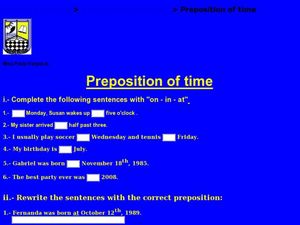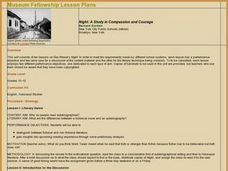Curated OER
New Year's Day: Crossword Puzzle
In this New Year's Day worksheet, learners read 16 clues pertaining to the celebration of a new year. Students fit their answers in a crossword puzzle.
Curated OER
Animals Active at Night
Young scholars identify animals that are active at night and the reasons why. They examine the features needed to be a nocturnal animal. They create a representation of one of the animals.
Curated OER
Measure
Students are asked what activities or things that they do each day. They are then asked do you do that in the morning, afternoon, or night? Students are then asked which of those things do you do first, second, third, and etc.
Curated OER
The Final Solution
Students distinguish between concentration, labor and death camps, describe conditions in concentration camps, read and discuss Night, by Elie Wiesel, and describe methods Nazis used to disguise true purpose of death camps and...
Curated OER
Shakespeare Club
Students explore literature dramatization. In this Shakespeare lesson, students discuss the characters from the play A Midsummer Night's Dream and construct costumes and a set.
Curated OER
Moon
Students discover scientific facts about the Moon and how
some American Indian Tribes used the moon to measure time.
They accomplish this by listening to stories and poetry, writing
stories, communicating with an astronaut,...
Curated OER
Time Lesson
Second graders observe a clock and discuss at what time of day they perform a certain task such as what time they wake up, go to sleep, etc. They use a clock and show what time they wake up in the morning differentiating whether it is...
GetWorksheets
Be My Valentine
If you're looking for a last-minute resource to help your class celebrate Valentine's Day in an educational way, browse through this selection of reading comprehension worksheets, which cover such topics as why the holiday is celebrated...
Curated OER
Preposition of Time
In this grammar worksheet, students fill in each blank in eighteen sentences with the appropriate preposition of time that makes each sentence grammatically correct.
Curated OER
"Night": A Study in Compassion and Courage
Students read the novel, "Night" by Elie Wiesel. Using excerpts from the novel, they complete a performance and literary technique objective. In groups, they finish handouts to give them more information on the Holocaust. They compare...
Curated OER
Time Zone Math
For this algebra worksheet, students calculate the different time of the day that different countries see the sun. They convert between different time zones. There are 3 questions with an answer key.
Curated OER
Spring Time Trees/Flowers
Plan ahead! Integrate science and language arts! Schedule your reading of C.S. Lewis’ The Lion, the Witch, and The Wardrobe to coincide with the arrival of spring. As pupils read Chapter 11 of the Lewis classic, they are assigned one of...
Curated OER
The Starry Night
Second graders fingerpaint their own interpretations of Vincent Van Gogh's Starry Night.
Curated OER
Twelfth Night: Thrusting Greatness Upon the Television (Series of 4)
Young scholars incorporate language from Twelfth Night into their own skits. In this Hamlet lesson, students use a handout to assist them as they dub over the skits created earlier with specific language from Twelfth...
Curated OER
Twelfth Night-The Musical!
Students read Shakespeare's Twelfth Night. In groups, they divide Act 2 and add a new character or direction to the plot. They reinterpret the scene as a musical, using contemporary songs.
Curated OER
Shakespeare Character Analysis Using "Twelfth Night"
Eighth graders complete a six-week unit on character analysis for the play "Twelfth Night" by William Shakespeare. They conduct research and write a report, participate in a book talk, and create a character analysis assignment to...
Poetry4kids
How to Host an Open Mic Poetry Party
Four steps to Open Mic Night! The location, invitations, supplies, and party favors are all part of the process in planning and hosting a fun-filled gathering where scholars read aloud an original poem or one by their favorite author.
Curated OER
Drive the Data Derby
Three days of race car design and driving through the classroom while guessing probability could be a third graders dream. Learn to record car speed, distances traveled, and statistics by using calculation ranges using the mean, median,...
Scouts
The Deadly Picnic: A Lab on Deductive Reasoning
Whodunnit? Find out who killed Mr. Brooks through a logical examination of evidence. Class members fill out a couple of data tables to help them pin down the suspect. After they've figured out just who the culprit is, pupils compose...
Nosapo
Getting to Know Each Other
How do you do? Guide learners through the basics of conversational English with an extensive set of discussion questions. Class members ask partners more about themselves, including their favorite hobbies, music, and time of day, as well...
Read Theory
Analogies 3 (Level 6)
Positive and negative may be opposites, but what does that have to do with the words clean and filthy? Ask your pupils to consider word relationships as they complete the 10 analogies presented here. Note that the exercise gradually...
Curated OER
The Learning Network: Alligators Everywhere Fill-In
Meant to be used with the article, "In Florida, the Natives Are Restless" (included here), this is a great source of high-interest, nonfiction reading. A fill in the blank vocabulary activity and an activity focusing on reading...
Alabama Learning Exchange
Our Restless Planet
Learners examine the topic of the Earth's rotation, revolution, and orbit. They observe teacher-led demonstrations, explore various websites, write journal entries, conduct a demonstration of why Earth experiences day and night, and...
Curated OER
Night Sounds
In this activity, children will discuss the different sounds they hear at night, sounds that they don't usually hear during the day. Then they will write and record a poem about these night sounds.

























